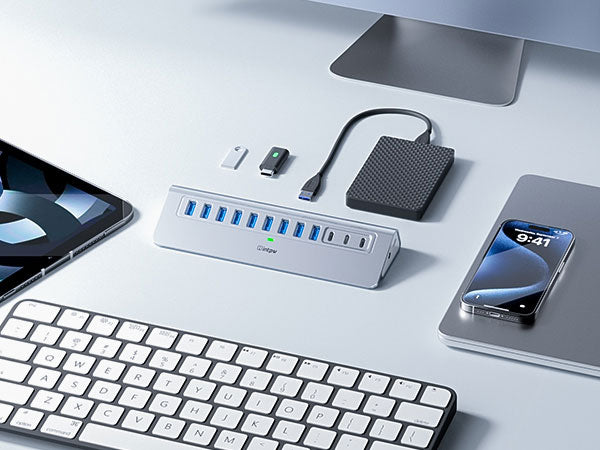
When Should You Replace Your USB Hub? Tips for Longevity and Maintenance
, by USintpw, 3 min reading time

, by USintpw, 3 min reading time
USB hubs have a lifespan, and knowing when to replace them can help maintain optimal performance. Here are the factors that affect the lifespan of your hub and tips on how to maximize its longevity.
How Long Does a USB Hub Last?
The lifespan of a USB hub depends on several factors, including its build quality, usage, and maintenance. On average, a well-built USB hub can last anywhere from 2 to 5 years. However, this can vary based on:
- Quality of Components: High-quality hubs made from durable materials, such as aluminum or high-grade plastic, tend to last longer.
- Power Supply: Hubs with proper power regulation and external power sources are less likely to wear out quickly.
- Technology Advancements: As newer USB standards (like USB 3.1 or USB 4) emerge, older hubs may become obsolete more quickly, even if they’re still functional.
Signs It's Time to Replace Your USB Hub
Even the best hubs will eventually show signs of wear. Here are some indicators that it might be time for a replacement:
- Slow Performance: If your hub consistently struggles to provide fast data transfer speeds or if devices frequently disconnect, it may be a sign that the internal components are degrading.
- Physical Damage: If the hub’s ports or cables are damaged, it may no longer function properly, leading to connectivity issues or failures.
- Overheating: Over time, hubs that lack proper ventilation or have faulty heat dissipation mechanisms can overheat, potentially damaging the hub and connected devices.
- Incompatibility with New Devices: As new USB standards like USB 3.1 and USB 4 are introduced, older hubs may not be compatible with the latest devices, resulting in slow speeds or failure to work altogether.
How to Maximize the Longevity of Your USB Hub
To get the most out of your USB hub and extend its lifespan, here are some helpful maintenance tips:
- Avoid Overloading: Don’t connect too many high-power devices simultaneously. Overloading can lead to overheating and reduce the hub’s performance.
- Keep It Cool: Ensure the hub is placed in a well-ventilated area to prevent overheating. Avoid covering it with objects or placing it in tight, enclosed spaces.
- Use Surge Protection: Power surges can damage your USB hub. Use a surge protector to keep your hub safe from electrical spikes.
- Regularly Update Drivers: Keep the drivers of your USB hub and connected devices up-to-date to ensure they’re working efficiently.
- Inspect Cables and Ports: Regularly check the cables and ports for any physical damage. Replace cables if they are frayed or damaged to avoid data loss or connectivity issues.
When Is It Better to Upgrade?
While USB hubs don’t have a specific expiration date, there are times when upgrading is the best option:
- Improved Speed and Performance: As technology advances, newer hubs offer faster data transfer speeds (USB 3.0, 3.1, and USB 4), which may benefit you if you’re working with large files or require high-performance peripherals.
- More Ports and Features: Upgrading may give you access to more ports, additional features (such as HDMI or Ethernet support), or enhanced charging capabilities that an older hub doesn’t provide.
- Increased Compatibility: If you’ve recently upgraded your laptop or PC, it may be worth investing in a hub that supports the latest USB standards and offers the best performance for your new device.
USB hubs can last several years if treated properly, but like any technology, their lifespan depends on usage, build quality, and technological changes. By recognizing when your hub starts to show signs of wear and taking steps to maintain it, you can ensure that it continues to provide seamless performance. If you notice slow speeds, physical damage, or compatibility issues, it may be time to replace or upgrade your USB hub for better performance and enhanced functionality.

Subscribe to our emails